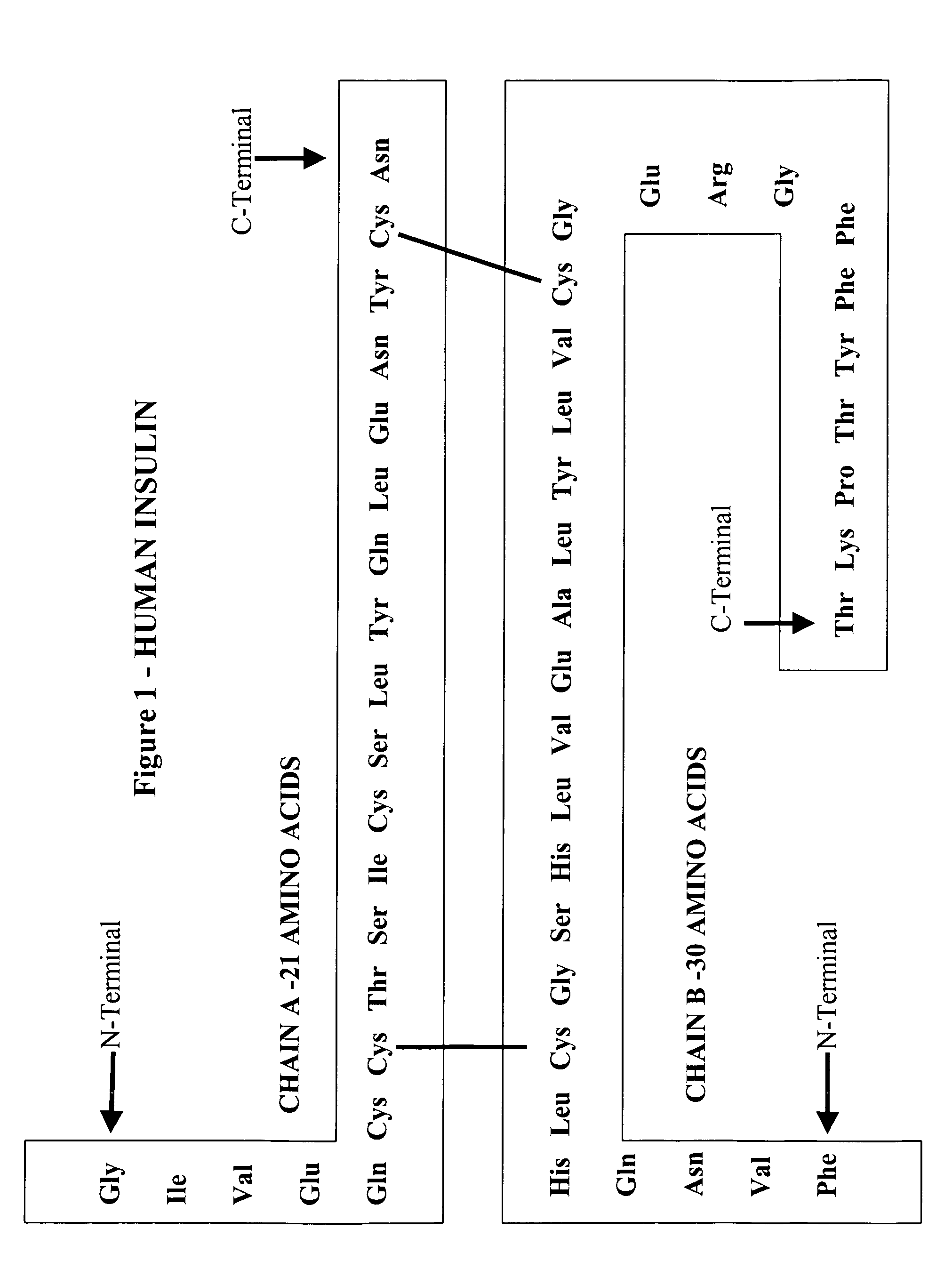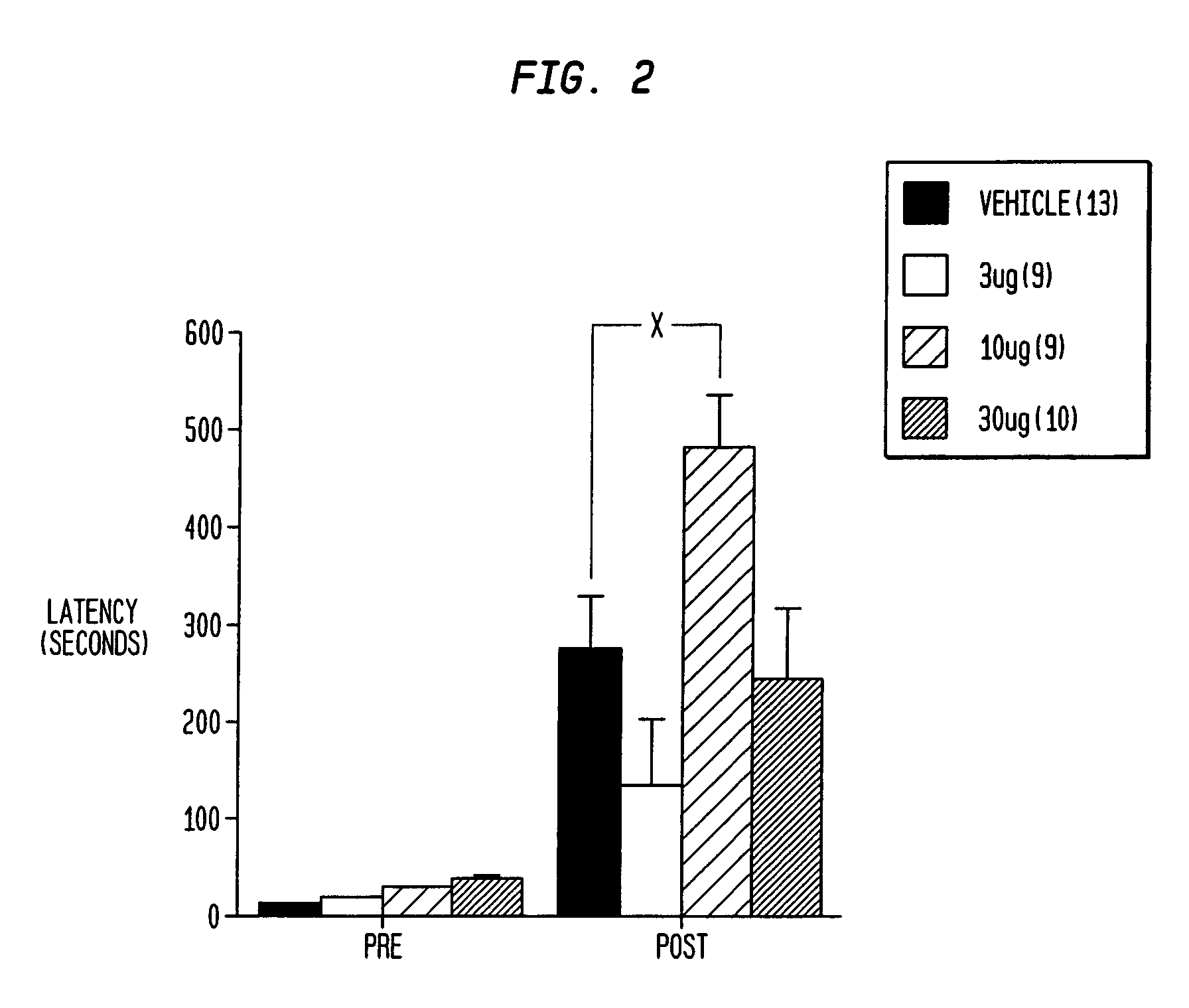Insulin-associated peptides with effects on cerebral health
a technology of peptides and peptides, applied in the field of neurology, can solve the problems of loss of short-term and/or long-term memory, memory impairment, and substantial interference with social and economic activities, and achieve the effects of improving spatial learning, efficient entry into the brain, and enhancing performan
- Summary
- Abstract
- Description
- Claims
- Application Information
AI Technical Summary
Benefits of technology
Problems solved by technology
Method used
Image
Examples
example 1
Materials and Methods
[0154](i) Materials
[0155]Male Sprague Dawley rats (˜300 gm) housed under controlled lighting and ad libituin food were used for all studies. All mice were tested at 8 weeks of age. Insulin, insulin A-chain, and insulin B-chain were obtained from Sigma (St. Louis, MO). Unless otherwise indicated insulin A-chain (Sigma l-1633) oxidized ammonium salt from bovine pancreas (Gly-Ile-Val-Glu-Gln-Cys (SO3 H)-Cys(SO3 H)-Ala-Ser-Val-Cys(SO3H)-Ser-Leu-Tyr-Gln-Leu-Glu-Asn-Tyr-Cys(503H)-Asn) (SEQ ID NO:5), insulin B-chain oxidized from bovine pancreas (Phe-Val-Asn-Gln-His-Leu-Cys (SO3H)-Gly-Ser-His-Leu-Val-Glu-Ala-Leu-Tyr-Leu-Val-Cys (S03 H) -Gly-Glu-Arg-Gly-Phe-Phe-Tyr-Thr-Pro-Lys-Ala) (SEQ ID NO :6), and insulin from bovine pancreas (C254H377N65O75S6) were used (SEQ ID NO:7 & SEQ ID NO:8).
[0156](ii) Intranasal Administration of Insulin or Insulin Associated Peptides to Rats
[0157]Insulin, insulin A-chain or B-chain was diluted in saline with 5-10% (2,6-DI—O-Methyl) β-cyclod...
example 2
Memory Enhancing Effects of Intranasal Insulin
[0165]FIG. 2 shows that intranasal insulin enhances associative learning in rats. Rats were anesthetized with isofluorane and then administered (intra-nasally) various doses of insulin (pretreatment time: 20 min). Rats were then placed in the light side of a two-chambered light / dark chamber, a guillotine door was closed and a 1.0 mA shock (3 sec) was administered. The door was then raised and the rat was allowed to re-enter the light side. Latency (max 600 sec) to enter the dark chamber was taken as a measurement of associative learning. Pretreatment with intra-nasal (3-30 μg, 28 USP units / mg) significantly (P<0.05) enhanced latency at the 10 μg does compared to vehicle (5% (2,6-DI—O-methyl)β-cyclodextrin) alone.
[0166]As shown in FIG. 2, intranasal insulin enhanced associative learning (at the 10μg dose) as measured by the passive avoidance behavioral paradigm. These results replicate a previous study that used the invasive intracerebrov...
example 3
Intranasal Insulin, A-Chain, and B-Chain Do Not Affect Blood Glucose Levels
[0169]In order to test the effects on blood glucose, rats were administered various doses of insulin, or A-chain, or B-chain intra-nasally, sacrificed, and then analyzed for blood glucose levels using a glucometer (Elite XL, Bayer).The doses of insulin and insulin A-chain that enhanced learning and memory did not have any effect on peripheral blood glucose (FIG. 4), which indicated that intranasal insulin produces potent memory enhancing effects. Rats (N-5 / group) were first anesthetized with isoflorane anesthesia and then administered vehicle (5% (2,6-DI—O-methyl)β-cyclodextrin) or insulin (3-30 μg, 28 USP units / mg) intra-nasally. Twenty minutes later, rats were sacrificed and blood glucose levels rapidly determined with a glucometer (Elite XL, Bayer). There were no significant differences between treatment groups as shown in FIG. 4.
PUM
| Property | Measurement | Unit |
|---|---|---|
| molecular weight | aaaaa | aaaaa |
| time | aaaaa | aaaaa |
| temperature | aaaaa | aaaaa |
Abstract
Description
Claims
Application Information
 Login to View More
Login to View More - R&D
- Intellectual Property
- Life Sciences
- Materials
- Tech Scout
- Unparalleled Data Quality
- Higher Quality Content
- 60% Fewer Hallucinations
Browse by: Latest US Patents, China's latest patents, Technical Efficacy Thesaurus, Application Domain, Technology Topic, Popular Technical Reports.
© 2025 PatSnap. All rights reserved.Legal|Privacy policy|Modern Slavery Act Transparency Statement|Sitemap|About US| Contact US: help@patsnap.com



